Rabin Medical Center
Rabin Medical Center (Hebrew: מרכז רפואי רבין) is a major hospital and medical center located in Petah Tikva, Israel.[1] It is owned and operated by Clalit Health Services, Israel's largest health maintenance organization. In January 1996, Beilinson Hospital and Hasharon Hospital were merged and renamed Rabin Medical Center. It has a capacity of 1,300 beds.[2]
| Rabin Medical Center | |
|---|---|
| Clalit Health Services | |
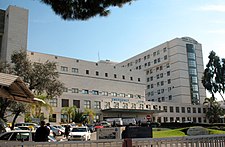 Rabin Medical Center | |
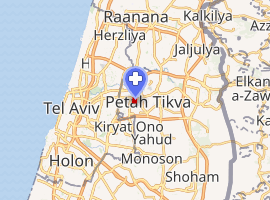
| |
| Geography | |
| Location | Petah Tikva, Israel |
| Services | |
| Beds | 1,300 |
| History | |
| Opened | January 1996 |
| Links | |
| Website | hospitals |
| Lists | Hospitals in Israel |
History
Beilinson Hospital
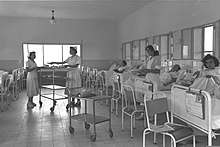
Beilinson Hospital was founded in 1936 to serve the nearby agricultural settlements.[2] All Jewish workers in central Palestine agreed to donate two days' worth of wages toward its construction. The hospital opened with 70 beds. It was named for Dr. Moshe Beilinson, one of its founders.
HaSharon Hospital was built in 1942 as an extension of Beilinson. In 1954, a new building in the International Style was designed by Arieh Sharon and Benjamin Idelson, pioneers of Israeli modernist architecture.[2]
In 1938, the country's first blood bank was established at Beilinson. Beilinson Hospital was the first medical institution in the country to have a dermatology department, a nephrology institute, and a dialysis unit. In 1968, the first heart transplant in Israel was performed there. The first implantation of an artificial heart in Israel was performed at Beilinson in 1995.
Schneider Children's Medical Center
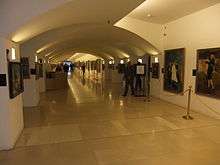
On October 29, 1991, the Schneider Children's Medical Center of Israel was founded on the hospital grounds, the largest such facility in Israel. It opened to the public in April 1992. It spans an area of 35,000 sq. meters. It was named after two major benefactors - Irving and Helen Schneider. It was designed by Marvin Bostin and Jerry Switzer.
In 2007, over 52,000 children were treated at the emergency ward of the center, over 15,000 staying for prolonged treatment. 21 children underwent organ transplants, including a heart transplant. 8,360 children underwent miscellaneous operations, of which 450 were heart and blood system operations.[3]
Golda–HaSharon Hospital
HaSharon Hospital was founded in 1942 by a team of surgeons from the Beilinson Hospital as a satellite surgical unit. It was originally established in a 1-floor building, and named Beilinson II. It originally had 28 beds. Beilinson II was renamed HaSharon Hospital several years later. In 1982, Golda was appended to the hospital's name, after the late Israeli prime minister, Golda Meir. Golda-HaSharon Hospital currently has 400 beds.
Merger
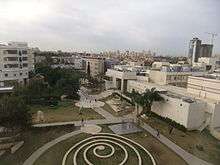
While physically separated, the two hospitals were officially merged in 1996 in a budget saving consolidation and the umbrella organization renamed the Rabin Medical Center, in memory of Yitzhak Rabin, the prime minister who had been assassinated in the previous year.
Clinical research
In 2012, the hospital received NIS 63.5 million in revenue for clinical research, after a 70% increase from 2011, topping the list for Israeli hospitals.[4]
See also
- Health care in Israel
- Medical tourism in Israel
References
- Ayala Hurwicz (2007-05-07). "Sheba - Largest Hospital in Israel" (in Hebrew). Retrieved 2007-09-14.
- Dvir, Noam (June 7, 2012). "A hospital's journey from architectural paean to beacon of bad taste". Haaretz.
- "Schneider - 52,000 Children Turned to the Emergency Ward" (in Hebrew). This Week in Petah Tikva - The Newspaper for the Religious Family. 2007-12-28. p. 4.
- Linder-Gantz, Roni (February 11, 2013). "Record Income For Hospitals for Clinical Research: NIS 370 Million". TheMarker (in Hebrew). Retrieved February 12, 2013.